Network Design and Configuration for Acme
VerifiedAdded on 2020/05/08
|10
|1741
|65
AI Summary
This assignment delves into the network infrastructure of Acme Inc., focusing on a redesign to incorporate IPv6 addressing and advanced routing techniques. It analyzes current network topology, proposes solutions using protocols like OSPF and BGP, and outlines VLAN segmentation for enhanced security and efficiency. The document also explores HSRP for increased network availability and includes hypothetical configurations for routers.
Contribute Materials
Your contribution can guide someone’s learning journey. Share your
documents today.

Running head: DESIGN NETWORK INFRASTRUCTURE
Design Network Infrastructure
Name of the Student
Name of the University
Author’s Note
Design Network Infrastructure
Name of the Student
Name of the University
Author’s Note
Secure Best Marks with AI Grader
Need help grading? Try our AI Grader for instant feedback on your assignments.

1
DESIGN NETWORK INFRASTRUCTURE
Table of Contents
Introduction..........................................................................................................................2
Discussion on protocols.......................................................................................................2
System testing and verification Strategy.............................................................................3
Network Design...................................................................................................................4
Issues identified in the network...........................................................................................4
Implementation and functionality........................................................................................5
Show run configuration of all the devices connected in the network..............................7
Recommendations and conclusions.....................................................................................8
Bibliography........................................................................................................................9
DESIGN NETWORK INFRASTRUCTURE
Table of Contents
Introduction..........................................................................................................................2
Discussion on protocols.......................................................................................................2
System testing and verification Strategy.............................................................................3
Network Design...................................................................................................................4
Issues identified in the network...........................................................................................4
Implementation and functionality........................................................................................5
Show run configuration of all the devices connected in the network..............................7
Recommendations and conclusions.....................................................................................8
Bibliography........................................................................................................................9
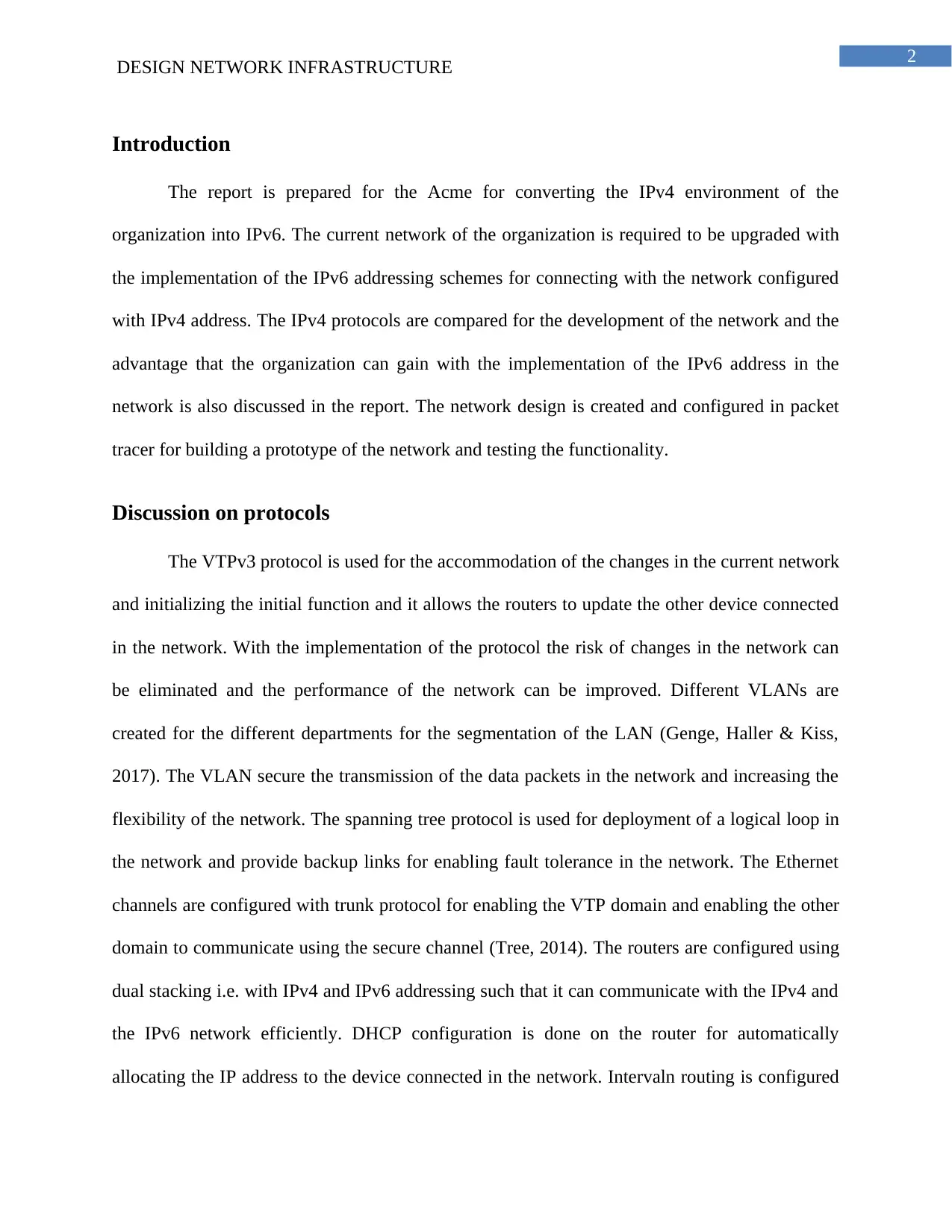
2
DESIGN NETWORK INFRASTRUCTURE
Introduction
The report is prepared for the Acme for converting the IPv4 environment of the
organization into IPv6. The current network of the organization is required to be upgraded with
the implementation of the IPv6 addressing schemes for connecting with the network configured
with IPv4 address. The IPv4 protocols are compared for the development of the network and the
advantage that the organization can gain with the implementation of the IPv6 address in the
network is also discussed in the report. The network design is created and configured in packet
tracer for building a prototype of the network and testing the functionality.
Discussion on protocols
The VTPv3 protocol is used for the accommodation of the changes in the current network
and initializing the initial function and it allows the routers to update the other device connected
in the network. With the implementation of the protocol the risk of changes in the network can
be eliminated and the performance of the network can be improved. Different VLANs are
created for the different departments for the segmentation of the LAN (Genge, Haller & Kiss,
2017). The VLAN secure the transmission of the data packets in the network and increasing the
flexibility of the network. The spanning tree protocol is used for deployment of a logical loop in
the network and provide backup links for enabling fault tolerance in the network. The Ethernet
channels are configured with trunk protocol for enabling the VTP domain and enabling the other
domain to communicate using the secure channel (Tree, 2014). The routers are configured using
dual stacking i.e. with IPv4 and IPv6 addressing such that it can communicate with the IPv4 and
the IPv6 network efficiently. DHCP configuration is done on the router for automatically
allocating the IP address to the device connected in the network. Intervaln routing is configured
DESIGN NETWORK INFRASTRUCTURE
Introduction
The report is prepared for the Acme for converting the IPv4 environment of the
organization into IPv6. The current network of the organization is required to be upgraded with
the implementation of the IPv6 addressing schemes for connecting with the network configured
with IPv4 address. The IPv4 protocols are compared for the development of the network and the
advantage that the organization can gain with the implementation of the IPv6 address in the
network is also discussed in the report. The network design is created and configured in packet
tracer for building a prototype of the network and testing the functionality.
Discussion on protocols
The VTPv3 protocol is used for the accommodation of the changes in the current network
and initializing the initial function and it allows the routers to update the other device connected
in the network. With the implementation of the protocol the risk of changes in the network can
be eliminated and the performance of the network can be improved. Different VLANs are
created for the different departments for the segmentation of the LAN (Genge, Haller & Kiss,
2017). The VLAN secure the transmission of the data packets in the network and increasing the
flexibility of the network. The spanning tree protocol is used for deployment of a logical loop in
the network and provide backup links for enabling fault tolerance in the network. The Ethernet
channels are configured with trunk protocol for enabling the VTP domain and enabling the other
domain to communicate using the secure channel (Tree, 2014). The routers are configured using
dual stacking i.e. with IPv4 and IPv6 addressing such that it can communicate with the IPv4 and
the IPv6 network efficiently. DHCP configuration is done on the router for automatically
allocating the IP address to the device connected in the network. Intervaln routing is configured
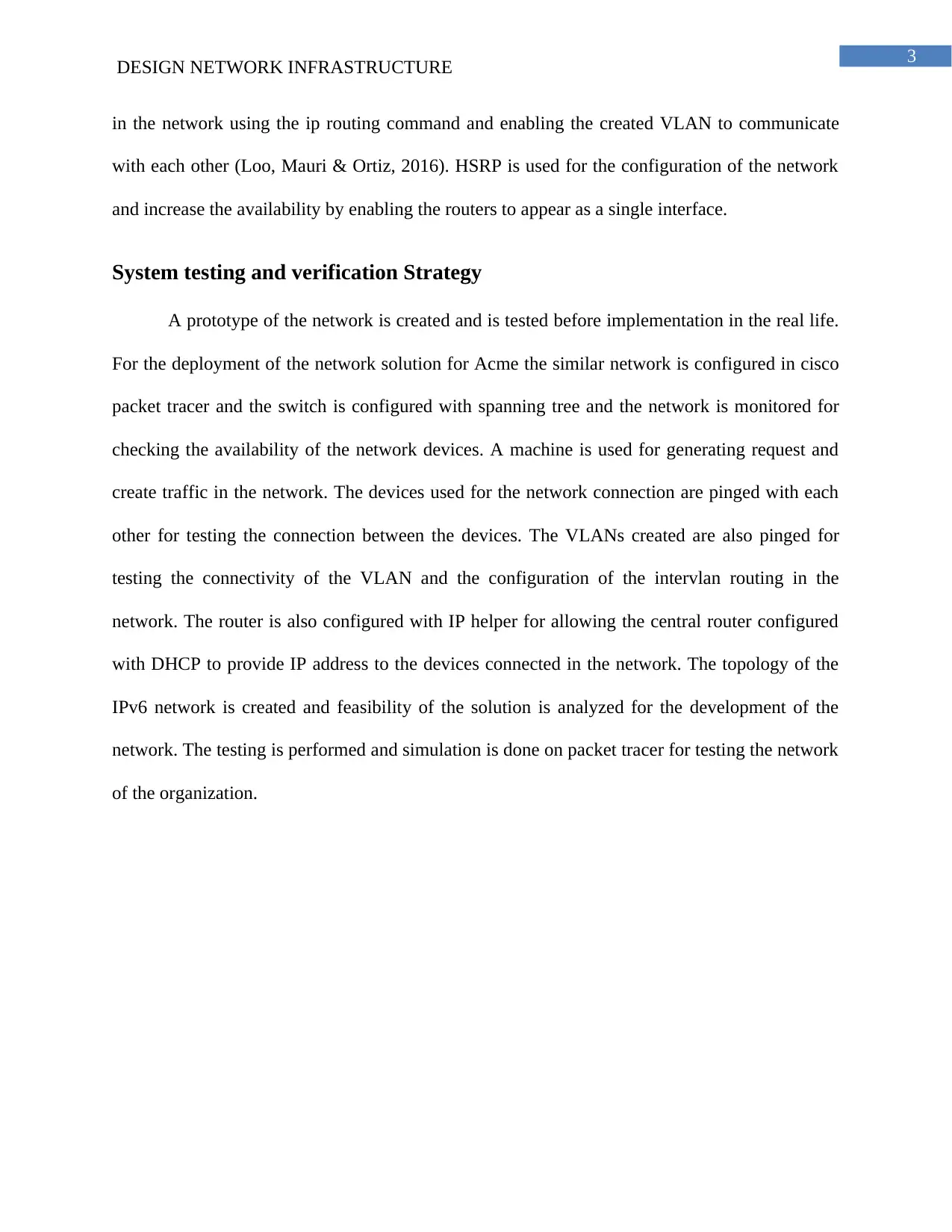
3
DESIGN NETWORK INFRASTRUCTURE
in the network using the ip routing command and enabling the created VLAN to communicate
with each other (Loo, Mauri & Ortiz, 2016). HSRP is used for the configuration of the network
and increase the availability by enabling the routers to appear as a single interface.
System testing and verification Strategy
A prototype of the network is created and is tested before implementation in the real life.
For the deployment of the network solution for Acme the similar network is configured in cisco
packet tracer and the switch is configured with spanning tree and the network is monitored for
checking the availability of the network devices. A machine is used for generating request and
create traffic in the network. The devices used for the network connection are pinged with each
other for testing the connection between the devices. The VLANs created are also pinged for
testing the connectivity of the VLAN and the configuration of the intervlan routing in the
network. The router is also configured with IP helper for allowing the central router configured
with DHCP to provide IP address to the devices connected in the network. The topology of the
IPv6 network is created and feasibility of the solution is analyzed for the development of the
network. The testing is performed and simulation is done on packet tracer for testing the network
of the organization.
DESIGN NETWORK INFRASTRUCTURE
in the network using the ip routing command and enabling the created VLAN to communicate
with each other (Loo, Mauri & Ortiz, 2016). HSRP is used for the configuration of the network
and increase the availability by enabling the routers to appear as a single interface.
System testing and verification Strategy
A prototype of the network is created and is tested before implementation in the real life.
For the deployment of the network solution for Acme the similar network is configured in cisco
packet tracer and the switch is configured with spanning tree and the network is monitored for
checking the availability of the network devices. A machine is used for generating request and
create traffic in the network. The devices used for the network connection are pinged with each
other for testing the connection between the devices. The VLANs created are also pinged for
testing the connectivity of the VLAN and the configuration of the intervlan routing in the
network. The router is also configured with IP helper for allowing the central router configured
with DHCP to provide IP address to the devices connected in the network. The topology of the
IPv6 network is created and feasibility of the solution is analyzed for the development of the
network. The testing is performed and simulation is done on packet tracer for testing the network
of the organization.
Secure Best Marks with AI Grader
Need help grading? Try our AI Grader for instant feedback on your assignments.
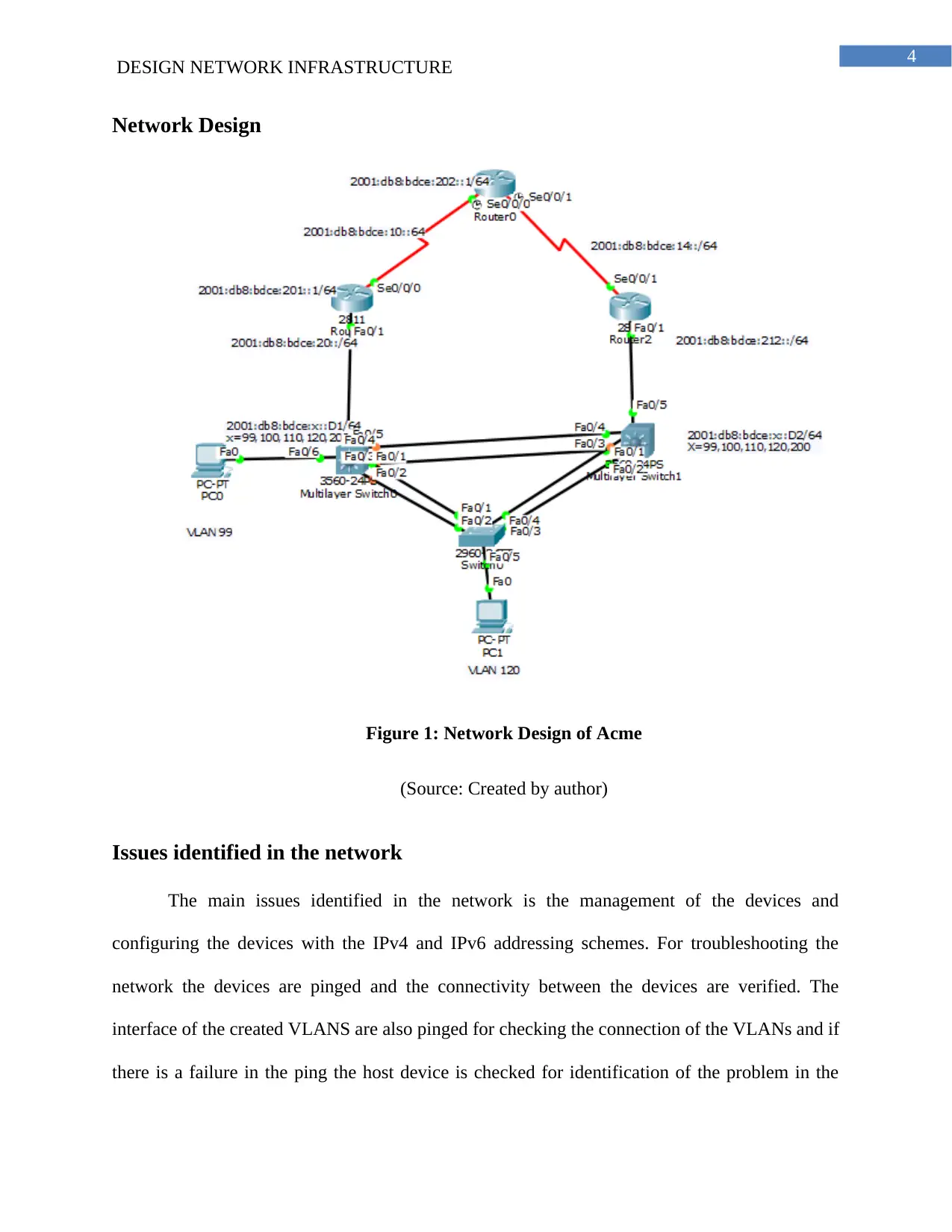
4
DESIGN NETWORK INFRASTRUCTURE
Network Design
Figure 1: Network Design of Acme
(Source: Created by author)
Issues identified in the network
The main issues identified in the network is the management of the devices and
configuring the devices with the IPv4 and IPv6 addressing schemes. For troubleshooting the
network the devices are pinged and the connectivity between the devices are verified. The
interface of the created VLANS are also pinged for checking the connection of the VLANs and if
there is a failure in the ping the host device is checked for identification of the problem in the
DESIGN NETWORK INFRASTRUCTURE
Network Design
Figure 1: Network Design of Acme
(Source: Created by author)
Issues identified in the network
The main issues identified in the network is the management of the devices and
configuring the devices with the IPv4 and IPv6 addressing schemes. For troubleshooting the
network the devices are pinged and the connectivity between the devices are verified. The
interface of the created VLANS are also pinged for checking the connection of the VLANs and if
there is a failure in the ping the host device is checked for identification of the problem in the
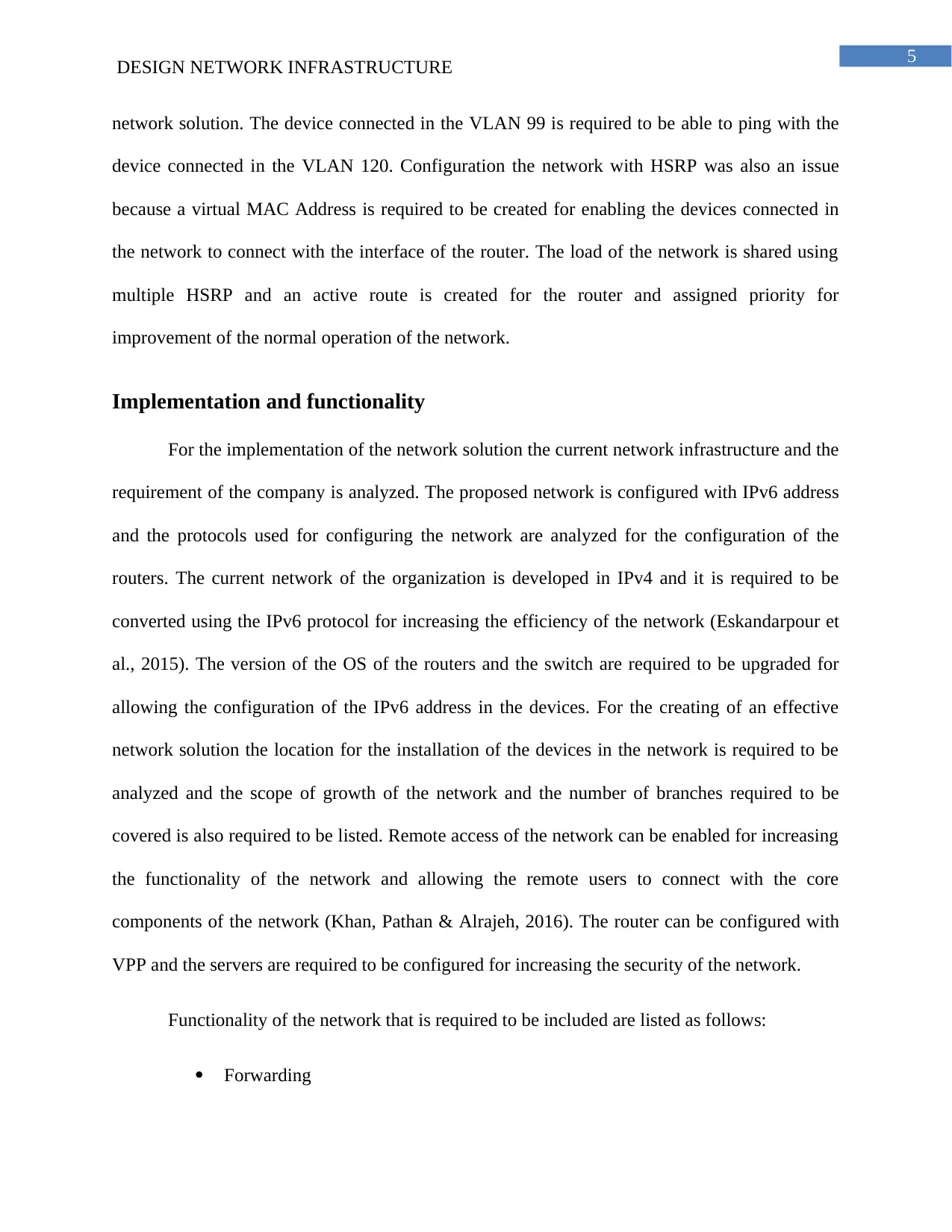
5
DESIGN NETWORK INFRASTRUCTURE
network solution. The device connected in the VLAN 99 is required to be able to ping with the
device connected in the VLAN 120. Configuration the network with HSRP was also an issue
because a virtual MAC Address is required to be created for enabling the devices connected in
the network to connect with the interface of the router. The load of the network is shared using
multiple HSRP and an active route is created for the router and assigned priority for
improvement of the normal operation of the network.
Implementation and functionality
For the implementation of the network solution the current network infrastructure and the
requirement of the company is analyzed. The proposed network is configured with IPv6 address
and the protocols used for configuring the network are analyzed for the configuration of the
routers. The current network of the organization is developed in IPv4 and it is required to be
converted using the IPv6 protocol for increasing the efficiency of the network (Eskandarpour et
al., 2015). The version of the OS of the routers and the switch are required to be upgraded for
allowing the configuration of the IPv6 address in the devices. For the creating of an effective
network solution the location for the installation of the devices in the network is required to be
analyzed and the scope of growth of the network and the number of branches required to be
covered is also required to be listed. Remote access of the network can be enabled for increasing
the functionality of the network and allowing the remote users to connect with the core
components of the network (Khan, Pathan & Alrajeh, 2016). The router can be configured with
VPP and the servers are required to be configured for increasing the security of the network.
Functionality of the network that is required to be included are listed as follows:
Forwarding
DESIGN NETWORK INFRASTRUCTURE
network solution. The device connected in the VLAN 99 is required to be able to ping with the
device connected in the VLAN 120. Configuration the network with HSRP was also an issue
because a virtual MAC Address is required to be created for enabling the devices connected in
the network to connect with the interface of the router. The load of the network is shared using
multiple HSRP and an active route is created for the router and assigned priority for
improvement of the normal operation of the network.
Implementation and functionality
For the implementation of the network solution the current network infrastructure and the
requirement of the company is analyzed. The proposed network is configured with IPv6 address
and the protocols used for configuring the network are analyzed for the configuration of the
routers. The current network of the organization is developed in IPv4 and it is required to be
converted using the IPv6 protocol for increasing the efficiency of the network (Eskandarpour et
al., 2015). The version of the OS of the routers and the switch are required to be upgraded for
allowing the configuration of the IPv6 address in the devices. For the creating of an effective
network solution the location for the installation of the devices in the network is required to be
analyzed and the scope of growth of the network and the number of branches required to be
covered is also required to be listed. Remote access of the network can be enabled for increasing
the functionality of the network and allowing the remote users to connect with the core
components of the network (Khan, Pathan & Alrajeh, 2016). The router can be configured with
VPP and the servers are required to be configured for increasing the security of the network.
Functionality of the network that is required to be included are listed as follows:
Forwarding
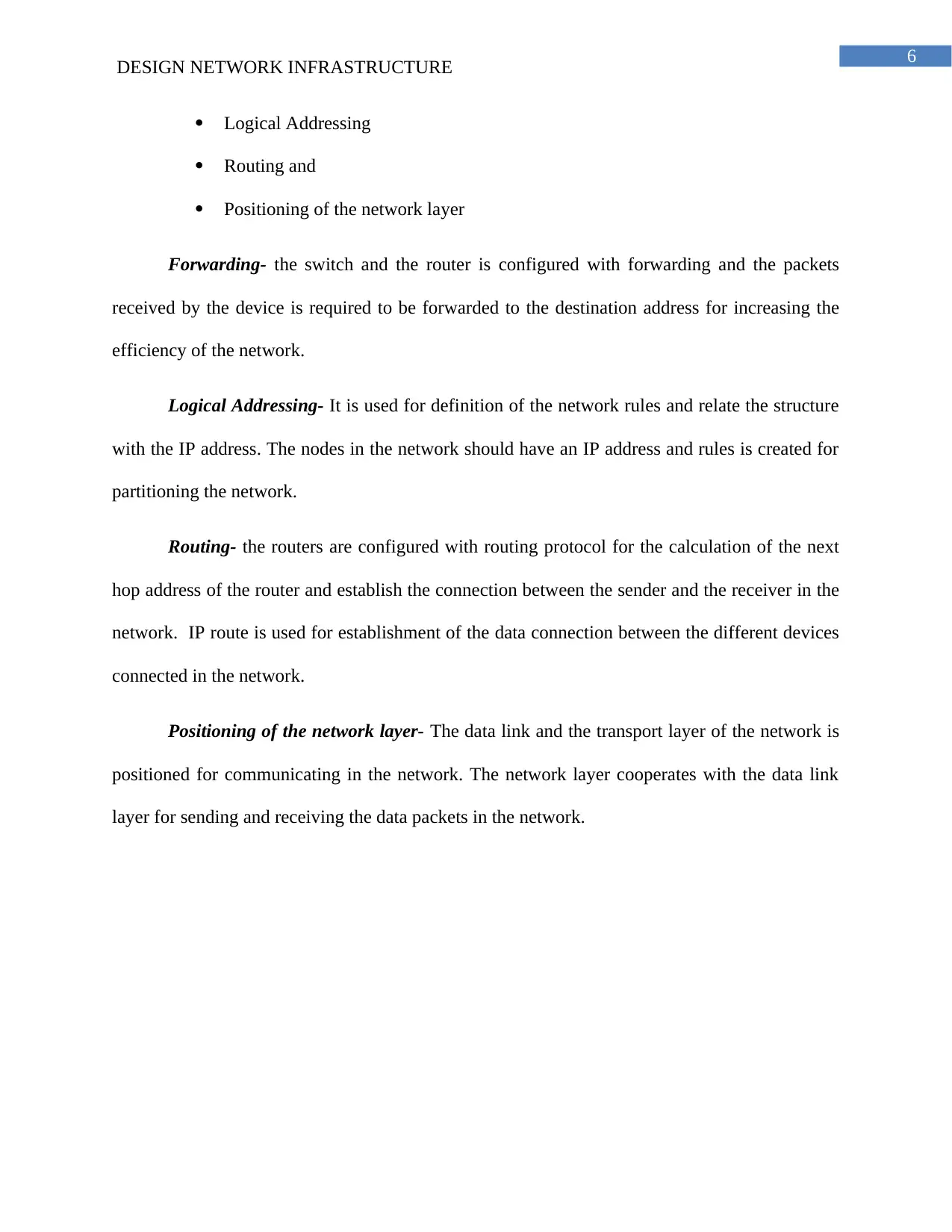
6
DESIGN NETWORK INFRASTRUCTURE
Logical Addressing
Routing and
Positioning of the network layer
Forwarding- the switch and the router is configured with forwarding and the packets
received by the device is required to be forwarded to the destination address for increasing the
efficiency of the network.
Logical Addressing- It is used for definition of the network rules and relate the structure
with the IP address. The nodes in the network should have an IP address and rules is created for
partitioning the network.
Routing- the routers are configured with routing protocol for the calculation of the next
hop address of the router and establish the connection between the sender and the receiver in the
network. IP route is used for establishment of the data connection between the different devices
connected in the network.
Positioning of the network layer- The data link and the transport layer of the network is
positioned for communicating in the network. The network layer cooperates with the data link
layer for sending and receiving the data packets in the network.
DESIGN NETWORK INFRASTRUCTURE
Logical Addressing
Routing and
Positioning of the network layer
Forwarding- the switch and the router is configured with forwarding and the packets
received by the device is required to be forwarded to the destination address for increasing the
efficiency of the network.
Logical Addressing- It is used for definition of the network rules and relate the structure
with the IP address. The nodes in the network should have an IP address and rules is created for
partitioning the network.
Routing- the routers are configured with routing protocol for the calculation of the next
hop address of the router and establish the connection between the sender and the receiver in the
network. IP route is used for establishment of the data connection between the different devices
connected in the network.
Positioning of the network layer- The data link and the transport layer of the network is
positioned for communicating in the network. The network layer cooperates with the data link
layer for sending and receiving the data packets in the network.
Paraphrase This Document
Need a fresh take? Get an instant paraphrase of this document with our AI Paraphraser
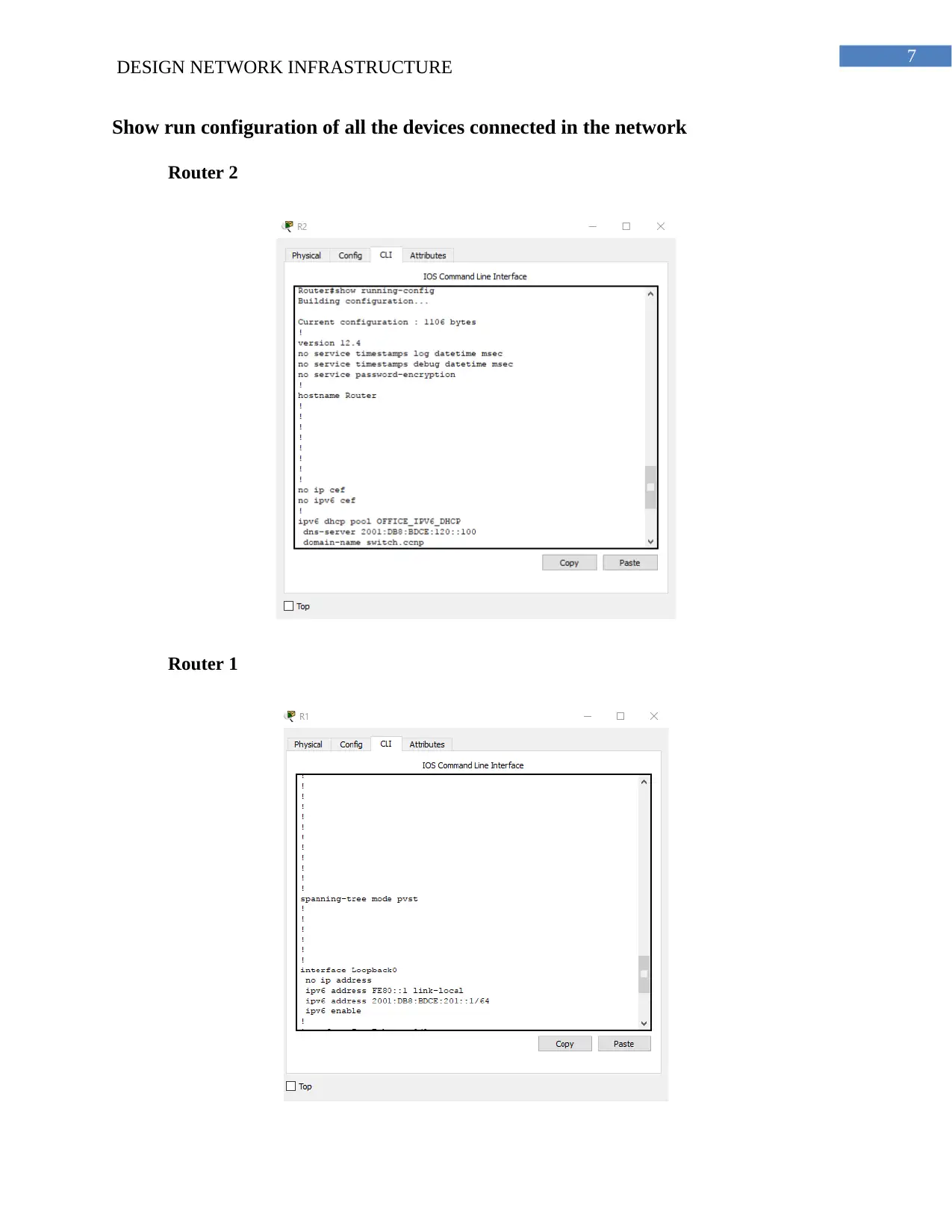
7
DESIGN NETWORK INFRASTRUCTURE
Show run configuration of all the devices connected in the network
Router 2
Router 1
DESIGN NETWORK INFRASTRUCTURE
Show run configuration of all the devices connected in the network
Router 2
Router 1
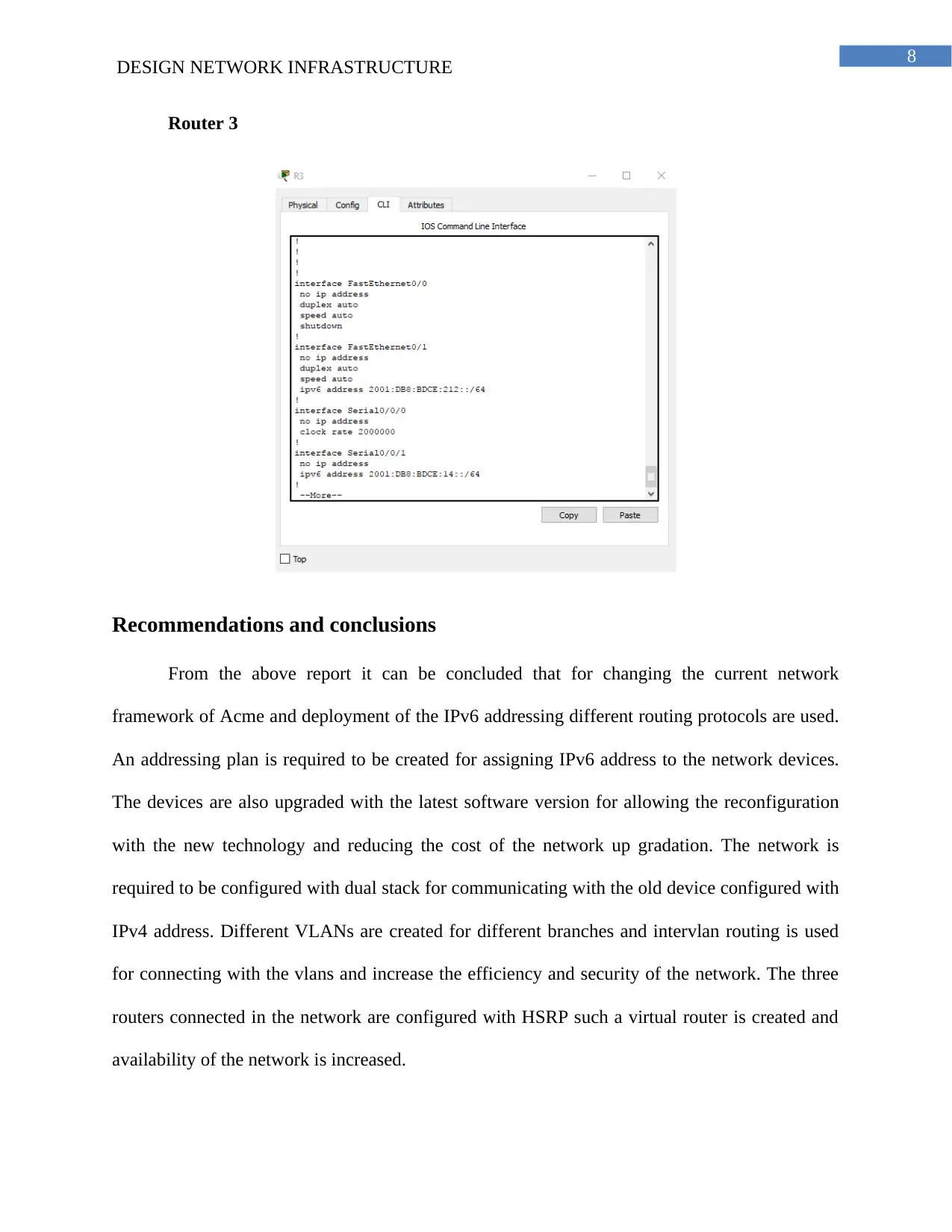
8
DESIGN NETWORK INFRASTRUCTURE
Router 3
Recommendations and conclusions
From the above report it can be concluded that for changing the current network
framework of Acme and deployment of the IPv6 addressing different routing protocols are used.
An addressing plan is required to be created for assigning IPv6 address to the network devices.
The devices are also upgraded with the latest software version for allowing the reconfiguration
with the new technology and reducing the cost of the network up gradation. The network is
required to be configured with dual stack for communicating with the old device configured with
IPv4 address. Different VLANs are created for different branches and intervlan routing is used
for connecting with the vlans and increase the efficiency and security of the network. The three
routers connected in the network are configured with HSRP such a virtual router is created and
availability of the network is increased.
DESIGN NETWORK INFRASTRUCTURE
Router 3
Recommendations and conclusions
From the above report it can be concluded that for changing the current network
framework of Acme and deployment of the IPv6 addressing different routing protocols are used.
An addressing plan is required to be created for assigning IPv6 address to the network devices.
The devices are also upgraded with the latest software version for allowing the reconfiguration
with the new technology and reducing the cost of the network up gradation. The network is
required to be configured with dual stack for communicating with the old device configured with
IPv4 address. Different VLANs are created for different branches and intervlan routing is used
for connecting with the vlans and increase the efficiency and security of the network. The three
routers connected in the network are configured with HSRP such a virtual router is created and
availability of the network is increased.
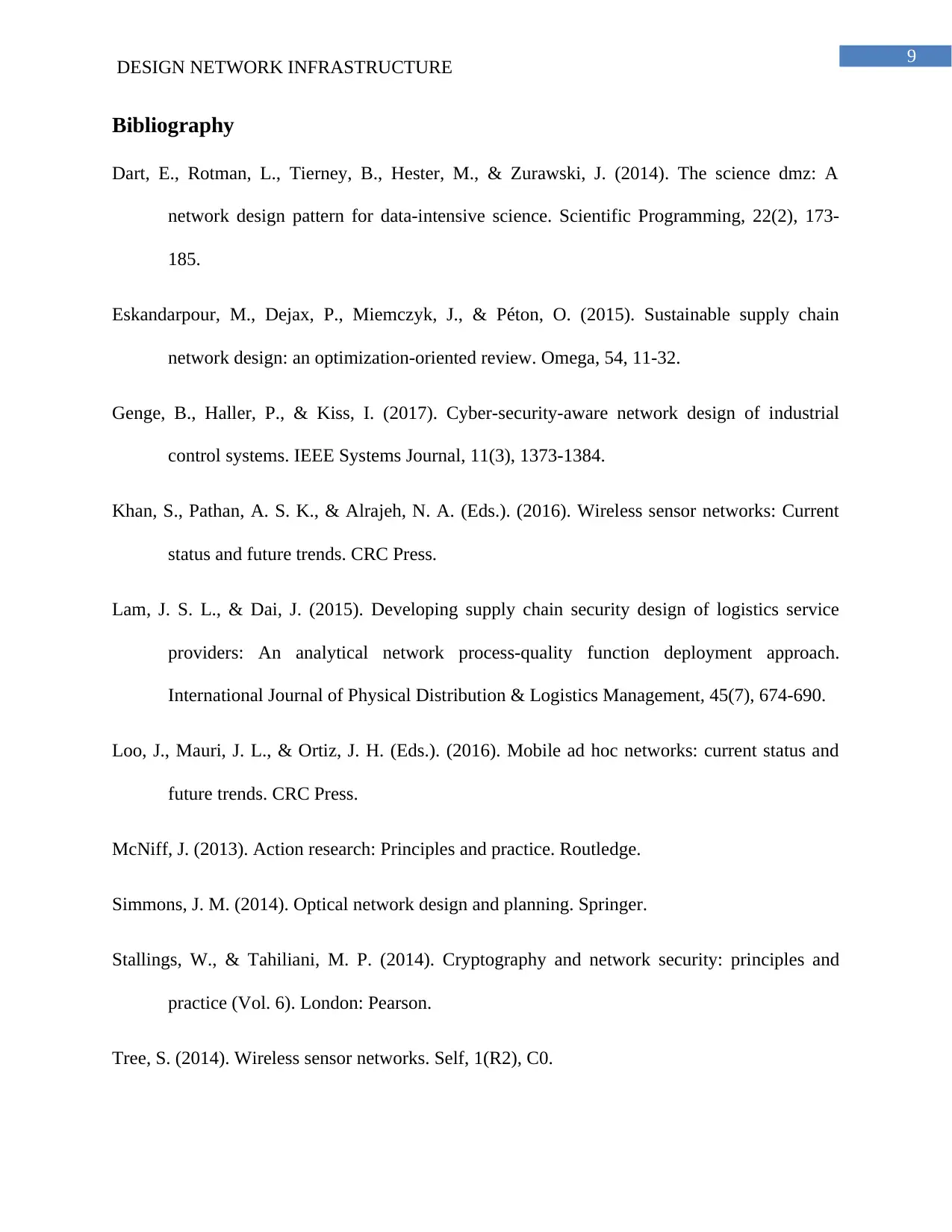
9
DESIGN NETWORK INFRASTRUCTURE
Bibliography
Dart, E., Rotman, L., Tierney, B., Hester, M., & Zurawski, J. (2014). The science dmz: A
network design pattern for data-intensive science. Scientific Programming, 22(2), 173-
185.
Eskandarpour, M., Dejax, P., Miemczyk, J., & Péton, O. (2015). Sustainable supply chain
network design: an optimization-oriented review. Omega, 54, 11-32.
Genge, B., Haller, P., & Kiss, I. (2017). Cyber-security-aware network design of industrial
control systems. IEEE Systems Journal, 11(3), 1373-1384.
Khan, S., Pathan, A. S. K., & Alrajeh, N. A. (Eds.). (2016). Wireless sensor networks: Current
status and future trends. CRC Press.
Lam, J. S. L., & Dai, J. (2015). Developing supply chain security design of logistics service
providers: An analytical network process-quality function deployment approach.
International Journal of Physical Distribution & Logistics Management, 45(7), 674-690.
Loo, J., Mauri, J. L., & Ortiz, J. H. (Eds.). (2016). Mobile ad hoc networks: current status and
future trends. CRC Press.
McNiff, J. (2013). Action research: Principles and practice. Routledge.
Simmons, J. M. (2014). Optical network design and planning. Springer.
Stallings, W., & Tahiliani, M. P. (2014). Cryptography and network security: principles and
practice (Vol. 6). London: Pearson.
Tree, S. (2014). Wireless sensor networks. Self, 1(R2), C0.
DESIGN NETWORK INFRASTRUCTURE
Bibliography
Dart, E., Rotman, L., Tierney, B., Hester, M., & Zurawski, J. (2014). The science dmz: A
network design pattern for data-intensive science. Scientific Programming, 22(2), 173-
185.
Eskandarpour, M., Dejax, P., Miemczyk, J., & Péton, O. (2015). Sustainable supply chain
network design: an optimization-oriented review. Omega, 54, 11-32.
Genge, B., Haller, P., & Kiss, I. (2017). Cyber-security-aware network design of industrial
control systems. IEEE Systems Journal, 11(3), 1373-1384.
Khan, S., Pathan, A. S. K., & Alrajeh, N. A. (Eds.). (2016). Wireless sensor networks: Current
status and future trends. CRC Press.
Lam, J. S. L., & Dai, J. (2015). Developing supply chain security design of logistics service
providers: An analytical network process-quality function deployment approach.
International Journal of Physical Distribution & Logistics Management, 45(7), 674-690.
Loo, J., Mauri, J. L., & Ortiz, J. H. (Eds.). (2016). Mobile ad hoc networks: current status and
future trends. CRC Press.
McNiff, J. (2013). Action research: Principles and practice. Routledge.
Simmons, J. M. (2014). Optical network design and planning. Springer.
Stallings, W., & Tahiliani, M. P. (2014). Cryptography and network security: principles and
practice (Vol. 6). London: Pearson.
Tree, S. (2014). Wireless sensor networks. Self, 1(R2), C0.
1 out of 10
Related Documents
Your All-in-One AI-Powered Toolkit for Academic Success.
+13062052269
info@desklib.com
Available 24*7 on WhatsApp / Email
![[object Object]](/_next/static/media/star-bottom.7253800d.svg)
Unlock your academic potential
© 2024 | Zucol Services PVT LTD | All rights reserved.




